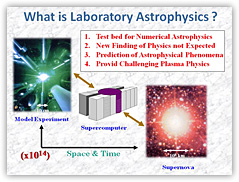
My research interest changed from the theoretical and computational study on nuclear fusion with intense lasers as application of science to that on pioneering a new fundamental science field called Laboratory Astrophysics (LA). LA is to study a variety of plasma astrophysical phenomena in laboratory with use of large-scale lasers and ultra-intense lasers originally developed for laser fusion by realizing a miniature Sun in laboratory; this means they can be also used to study of stellar physics and many of extreme plasma phenomena in Universe. If the basic equations are the same between laser plasma and astrophysical plasma, a computer does not know which physics it is solving. LA is a new method to study astrophysics experimentally. LA provides a good test bed for numerical astrophysics at first. The second interest id to find new physics in LA experiments which we did not expected before the experiment. Thirdly, we can also expect to predict new phenomena in Universe based on the experimental evidence and computational analysis. As the result, we can also provide exciting and challenging subjects in nonlinear and relativistic plasma physics. Both phenomena in laboratory and in Universe are speculated to be controlled by the same physics, regardless of how large scale down in time and space we do in LA model experiments.

Schematic image showing the concept of Laboratory Astrophysics. In this research a tight binding of theory and computer simulation, astrophysical observation, and laser plasma experiment is essential.

![]()
X-ray astronomy in the laboratory with a miniature compact object produced by laser-driven implosion, S. Fujioka, H. Takabe and 16 authors from 4 countries, Nature Physics 5, 821 - 825 (2009).
![]() Please follow the link.
Please follow the link.
![]()
Time-dependent simulation of photo-ionized plasma created by laboratory blackbody radiator, FL Wang, D. Salzmann, G. Zhao, H. Takabe, S. Fujioka, N. Yamamoto, H. Nishimura, and J. Zhang, The Astrophysical Journal, 706, 592-598 (2009).
![]() Please follow the link.
Please follow the link.
![]()
Laboratory Astrophysics – New approach to the physics of astrophysics, H. Takabe, AAPPS Bulletin, Vol. 19, No. 3, 43-54 (2009)
![]() Please follow the link.
Please follow the link.
![]()
High-Mach number collisionless shock and photo-ionized non-LTE plasma for laboratory astrophysics with intense lasers, H Takabe and 45 authors from 5 countries, Plasma Phys. Control. Fusion 50, 124057 (15pp) (2008)
![]() Please follow the link.
Please follow the link.
![]()
Non-relativistic collisionless shocks in un-magnetized electron-ion plasmas, T. N. Kato and H. Takabe, The Astrophysical Journal, 681, L93-L96 (2008)
![]() Please follow the link.
Please follow the link.

Hideaki Takabe called as "Aki" in speaking in English received the Ph.D degree in nuclear fusion integrated physics from Osaka University in 1980. He worked for Max-Planck Institute for Plasma Physics, Germany (1980-1981) and University of Arizona, USA (1981-1982). He is Professor at Institute of Laser Energetics and Dep. Physics and Space & Earth Science, School of Science, Osaka University from 1997. He is Fellow of American Physical Society (2000), awarded "Edward Teller Medal" from American Nuclear Society (2003), Honorary Professor of National Astronomical Observatory, Beijing (2006), Distinguished Guest Professor, Shanghai Jiao Tong University (2008). He is a council member of Asia-Pacific Physical Society (2005-2010). His major is Plasma Physics, Astrophysics, and Computational Physics. He is now the project leader of "Laser Astrophysics" consists of one theoretical group and four experimental groups, collaborating with UK, France, Israel, China, Korea, and USA.

